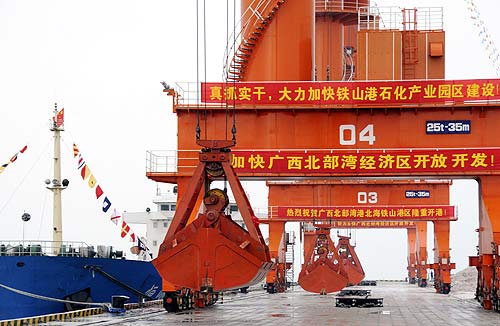|
 |
|
SOUND HARBOR: Beihai Tieshan Port, in Guangxi Zhuang Autonomous Region, is an important link in connecting the southwestern and southern parts of China, as well as ASEAN countries (LI QUNGUANG) |
Accelerated construction
The construction of the corridor involves seven countries, with each representing different functions and interests. A major concern for all involved countries is whether the corridor can bring economic benefits and social stability. Gu said the concerns of each country have raised questions and challenges in the construction of the corridor, in spite of the positive impacts.
Ma suggested that, in order to seize the opportunity to develop the economic corridor and to upgrade pan-Beibu Gulf economic cooperation to a new level, a joint expert team be set up as soon as possible. Based on the advice from the expert team, the governments of the nations involved should hold multilateral and bilateral negotiations, conduct dialogues and cooperation in a timely and effective manner, research and resolve key problems, make relevant plans, speed up the implementation of relevant projects, strengthen regional and cross-border flows of all kinds of resources, promote the construction of a cross-border economic corridor featuring complementary advantages, form a regional division of labor and pursue joint exploration and common development.
Ma said the involved nations should upgrade the corridor to a sub-regional cooperation project under the framework of China and ASEAN, and look for financing from the China-ASEAN investment cooperation fund and credit capital for further construction.
Ma suggested holding a corridor forum each year, where experts and entrepreneurs from relevant nations can introduce joint research, expand public influence and increase common ground. This would allow more people along the corridor to be involved in its construction.
Ma said the Beibu Gulf economic zone in Guangxi is an important link in the corridor. He suggested that all involved parties take advantage of Guangxi's listing as a free cross-border renminbi settlement trial location to expand trade cooperation, strengthen investment and cooperation and promote the development of coastal hi-tech and modern service industries, as well as promote the capacity of the corridor and create a new engine for the economic corridor.
Railway and expressway construction is key to developing the corridor. Lin Zhonghong, Vice President of Economic and Planning Research at the Institute of the Ministry of Railways, said at the forum that the ministry will give full support to railway construction between Nanning and Singapore. The Nanning-Singapore railway is estimated to be 5,000 km long, with 198 km in China's territory. All but 435 of the 5,000 km is complete.
Sun Yongfu, member of the Standing Committee of the Chinese People's Political Consultative Conference and former Vice Minister of Railways, said the preparation work for the railway section in Chinese territory—from Nanning to Pinxiang—has been proceeding smoothly. The feasibility report has already been approved. The Chinese Ministry of Railways will cooperate with relevant countries, research problems involving construction of international railways, and actively promote the Nanning-Singapore railway construction.
Pan-Beibu Gulf
The Beibu Gulf is located in the northwestern part of the South Sea of China and is bordered by the coastal areas of Guangxi Zhuang Autonomous Region, Guangdong and Hainan provinces and part of Viet Nam.
On July 20, 2006, at a pan-Beibu Gulf economic cooperation forum held in Nanning, Guangxi, the concept of building a pan-Beibu Gulf economic cooperation zone included seven countries: China, Viet Nam, Malaysia, Singapore, Indonesia, the Philippines and Brunei.
The pan-Beibu Gulf economic cooperation falls into the framework of a free trade zone of China and ASEAN.
China-ASEAN Trade Figures
In the first six months of 2010, bilateral trade between China and ASEAN members stood at $136.5 billion, growing 55 percent from a year earlier. China imported goods worth $71.9 billion from ASEAN, up 64 percent, and exported $64.6 billion to ASEAN, up 45 percent. China's imports from ASEAN grew faster than its exports to ASEAN, resulting in China's deficit of $7.3 billion. During the same time, China's non-financial investment in ASEAN stood at $1.22 billion, up 125.7 percent year on year.
|
